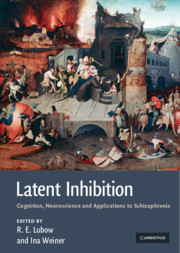Book contents
- Frontmatter
- Contents
- List of contributors
- Preface
- 1 A short history of latent inhibition research
- Current topics in latent inhibition research
- 2 Latent inhibition and extinction: their signature phenomena and the role of prediction error
- 3 Inter-stage context and time as determinants of latent inhibition
- 4 Latent inhibition: acquisition or performance deficit?
- 5 Latent inhibition and learned irrelevance in human contingency learning
- 6 Associative and nonassociative processes in latent inhibition: an elaboration of the Pearce–Hall model
- 7 From latent inhibition to retrospective revaluation: an attentional-associative model
- 8 Latent inhibition and habituation: evaluation of an associative analysis
- 9 Latent inhibition and creativity
- 10 The phylogenetic distribution of latent inhibition
- 11 The genetics of latent inhibition: studies of inbred and mutant mice
- 12 A comparison of mechanisms underlying the CS–US association and the CS–nothing association
- 13 The pharmacology of latent inhibition and its relevance to schizophrenia
- 14 Parahippocampal region–dopaminergic neuron relationships in latent inhibition
- 15 Latent inhibition and other salience modulation effects: same neural substrates?
- 16 What the brain teaches us about latent inhibition (LI): the neural substrates of the expression and prevention of LI
- 17 Latent inhibition in schizophrenia and schizotypy: a review of the empirical literature
- 18 A cautionary note about latent inhibition in schizophrenia: are we ignoring relevant information?
- 19 Latent inhibition as a function of anxiety and stress: implications for schizophrenia
- 20 Nicotinic modulation of attentional deficits in schizophrenia
- 21 Latent inhibition and schizophrenia: the ins and outs of context
- Summary and conclusions
- Index
- References
12 - A comparison of mechanisms underlying the CS–US association and the CS–nothing association
from Current topics in latent inhibition research
Published online by Cambridge University Press: 04 August 2010
- Frontmatter
- Contents
- List of contributors
- Preface
- 1 A short history of latent inhibition research
- Current topics in latent inhibition research
- 2 Latent inhibition and extinction: their signature phenomena and the role of prediction error
- 3 Inter-stage context and time as determinants of latent inhibition
- 4 Latent inhibition: acquisition or performance deficit?
- 5 Latent inhibition and learned irrelevance in human contingency learning
- 6 Associative and nonassociative processes in latent inhibition: an elaboration of the Pearce–Hall model
- 7 From latent inhibition to retrospective revaluation: an attentional-associative model
- 8 Latent inhibition and habituation: evaluation of an associative analysis
- 9 Latent inhibition and creativity
- 10 The phylogenetic distribution of latent inhibition
- 11 The genetics of latent inhibition: studies of inbred and mutant mice
- 12 A comparison of mechanisms underlying the CS–US association and the CS–nothing association
- 13 The pharmacology of latent inhibition and its relevance to schizophrenia
- 14 Parahippocampal region–dopaminergic neuron relationships in latent inhibition
- 15 Latent inhibition and other salience modulation effects: same neural substrates?
- 16 What the brain teaches us about latent inhibition (LI): the neural substrates of the expression and prevention of LI
- 17 Latent inhibition in schizophrenia and schizotypy: a review of the empirical literature
- 18 A cautionary note about latent inhibition in schizophrenia: are we ignoring relevant information?
- 19 Latent inhibition as a function of anxiety and stress: implications for schizophrenia
- 20 Nicotinic modulation of attentional deficits in schizophrenia
- 21 Latent inhibition and schizophrenia: the ins and outs of context
- Summary and conclusions
- Index
- References
Summary
The ability to adapt to environmental change is essential for the survival of any organism. Adaptations to environmental change include the ability to learn associations and the ability to modify those associations. Numerous studies have demonstrated that deficits in the ability to modify or modulate learning are associated with multiple mental illnesses and disorders (Amieva, Phillips, Della, & Henry, 2004; Baron-Cohen & Belmonte, 2005; Baruch, Hemsley, & Gray, 1988; Clark & Goodwin, 2004; Kaplan et al., 2006; Lubow & Gewirtz, 1995; Lubow & Josman, 1993; Vaitl, Lipp, Bauer et al., 1999; Weiner, Schiller, & Gaisler-Salomon, 2003). Because of the strong link between mental illness and deficits in processes that modulate learning, understanding the neural substrates of these processes could facilitate development of treatments for many diseases. Latent inhibition is one process that can modulate learned associations and is also altered in patients with mental illness (see the chapters on schizophrenia in this book for an in-depth discussion).
As described in preceding chapters in this book, latent inhibition is the phenomenon in which pre-exposure to a conditioned stimulus (CS) prior to the pairing of this CS with an unconditioned stimulus (US) decreases the subsequent conditioned responses (CR). There are three phases of latent inhibition: (1) pre-exposure to the CS, (2) training (or conditioning), and (3) testing. The presence of latent inhibition is identified by comparing the degree of conditioned responding between the CS pre-exposed group and the non-pre-exposed group.
- Type
- Chapter
- Information
- Latent InhibitionCognition, Neuroscience and Applications to Schizophrenia, pp. 252 - 275Publisher: Cambridge University PressPrint publication year: 2010



